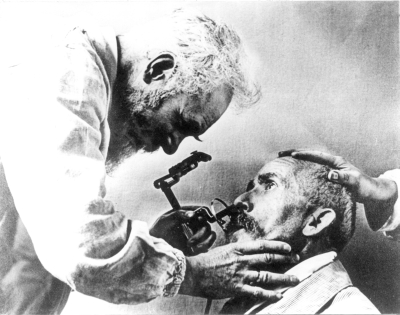|
Killian's Triangle
Killian's dehiscence (also known as Killian's triangle) is a triangular area in the wall of the pharynx between the cricopharyngeus (upper esophageal sphincter (UES)) and thyropharyngeus (Inferior pharyngeal constrictor muscle) which are the two parts of the inferior constrictors (also see Pharyngeal pouch). It can be seen as a locus minoris resistentiae. A similar triangular area between circular fibres of the cricopharyngeus and longitudinal fibres of the esophagus is Lamier's triangle or Lamier-hackermann's area. Clinical significance It represents a potentially weak spot where a pharyngoesophageal diverticulum ( Zenker's diverticulum) is more likely to occur. Eponym It is named after the German ENT surgeon Gustav Killian Gustav Killian (2 June 1860 – 24 February 1921) was a Germans, German Laryngology, laryngologist and founder of the bronchoscopy. Life and death His father Johann Baptist Caesar Killian (1820–1889), the son of a ''städtischen Wegeaufsehers'' a .... Ref ... [...More Info...] [...Related Items...] OR: [Wikipedia] [Google] [Baidu] |
Human Pharynx
The pharynx (: pharynges) is the part of the throat behind the mouth and nasal cavity, and above the esophagus and trachea (the tubes going down to the stomach and the lungs respectively). It is found in vertebrates and invertebrates, though its structure varies across species. The pharynx carries food to the esophagus and air to the larynx. The flap of cartilage called the epiglottis stops food from entering the larynx. In humans, the pharynx is part of the digestive system and the conducting zone of the respiratory system. (The conducting zone—which also includes the nostrils of the nose, the larynx, trachea, bronchi, and bronchioles—filters, warms, and moistens air and conducts it into the lungs). The human pharynx is conventionally divided into three sections: the nasopharynx, oropharynx, and laryngopharynx (hypopharynx). In humans, two sets of pharyngeal muscles form the pharynx and determine the shape of its lumen. They are arranged as an inner layer of longitudinal ... [...More Info...] [...Related Items...] OR: [Wikipedia] [Google] [Baidu] |
Zenker's Diverticulum
A Zenker's diverticulum, also pharyngeal pouch, is a diverticulum of the mucosa of the human pharynx, just above the cricopharyngeal muscle (i.e. above the upper sphincter of the esophagus). It is a pseudo diverticulum or false diverticulum (only involving the mucosa and submucosa of the esophageal wall, not the adventitia), also known as a pulsion diverticulum. It was named in 1877 after German pathologist Friedrich Albert von Zenker. Signs and symptoms When there is excessive pressure within the lower pharynx, the weakest portion of the pharyngeal wall balloons out, forming a diverticulum which may reach several centimetres in diameter. While traction and pulsion mechanisms have long been deemed the main factors promoting development of a Zenker's diverticulum, current consensus considers occlusive mechanisms to be most important: uncoordinated swallowing, impaired relaxation and spasm of the cricopharyngeus muscle lead to an increase in pressure within the distal pharynx, ... [...More Info...] [...Related Items...] OR: [Wikipedia] [Google] [Baidu] |
Gustav Killian
Gustav Killian (2 June 1860 – 24 February 1921) was a Germans, German Laryngology, laryngologist and founder of the bronchoscopy. Life and death His father Johann Baptist Caesar Killian (1820–1889), the son of a ''städtischen Wegeaufsehers'' an urban way overseer, was a ''doctor of philosophiae'' and high school teacher born in Mainz and later living in Bensheim. His mother Apollonia (1833–1865), née Höpfel died early, at age 31 of cholera. He was also born in Mainz, and educated at the Albert Ludwigs University of Freiburg, University of Freiburg-im-Breisgau. He made revolutionary advances in the diagnosis and treatment of affections of the infralaryngeal passages, especially in the diagnosis and removal of foreign bodies in the Bronchus, bronchial tubes, by means of his new art of bronchoscopic control. His first college appointment was as assistant to Professor Hack of the chair of otolaryngology in Mainz. The sudden death of Wilhelm Hack (1851–1887) led to his suc ... [...More Info...] [...Related Items...] OR: [Wikipedia] [Google] [Baidu] |
Human Head And Neck
Humans (''Homo sapiens'') or modern humans are the most common and widespread species of primate, and the last surviving species of the genus ''Homo''. They are great apes characterized by their hairlessness, bipedalism, and high intelligence. Humans have large brains, enabling more advanced cognitive skills that facilitate successful adaptation to varied environments, development of sophisticated tools, and formation of complex social structures and civilizations. Humans are highly social, with individual humans tending to belong to a multi-layered network of distinct social groups — from families and peer groups to corporations and political states. As such, social interactions between humans have established a wide variety of values, social norms, languages, and traditions (collectively termed institutions), each of which bolsters human society. Humans are also highly curious: the desire to understand and influence phenomena has motivated humanity's deve ... [...More Info...] [...Related Items...] OR: [Wikipedia] [Google] [Baidu] |


